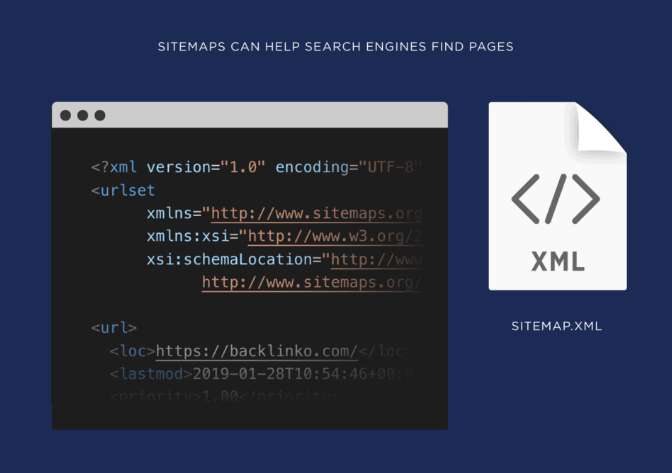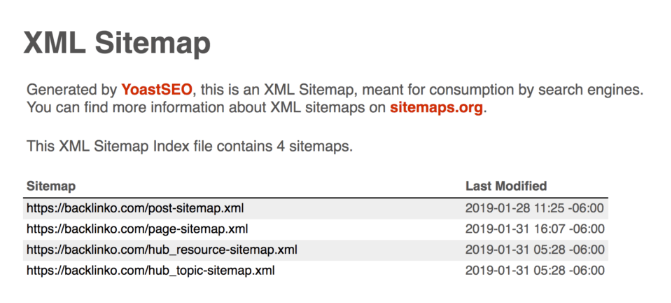At its most basic, a sitemap is a file that lists out the URLs to pages of your website. It provides information about your site’s pages and other features, as well as how everything’s related from page to page and file to file.
While sitemaps are something that human users can find helpful, they’re more often used by search engines by giving them a pathway to more efficiently crawl your site . During this process, the sitemap provides a, well, “map,” as it were, guiding the search crawler through your site and emphasizing what you deem to be the most critical information for the crawler to know.
The two main types of sitemaps and why they matter
Most sitemaps will fall into one of two categories: HTML, or XML. There are also RSS feeds and text sitemaps, but we’ll focus on these two since they’re the most relevant for this purpose.
The practical difference between these two is that XML is pretty much just for search engines, not humans, while HTML sitemaps are the kind that human users can look at too. When you’re on a site and see the “sitemap” link — often in the footer when you scroll to the bottom of a page — what you’re getting there is an HTML one. While search engine web crawlers can access these sitemaps too, the distinguishing factor of HTML is that it allows users to see the structure of your site more clearly, making it easier for them to navigate.
XML, on the other hand, is specifically for search engine use.
Image Source: backlinko.com
This type of sitemap shares details that are more technically oriented. One of those details is the frequency with which a page is updated — this is important because if the web crawler sees pages have been updated recently, its “thought” process (for lack of better words) is “Hey, these guys are updating their work often. That must mean they’re up-to-date, with the best information available!”
Ergo, in the web crawler’s mind, you’re more relevant, and it will subsequently rank you higher.
Now, more on why this matters:
To start off with, Google does provide reasons why you might not need a sitemap. Generally speaking, you could fall under this category if your site is new and small, and all your pages are well-linked to each other — i.e., no orphaned pages just floating around in the abyss.
Still, it’s better to assume you do benefit from one, seeing as that’s a far safer assumption.
If your site isn’t constructed super well and thus is neither optimized for human nor web crawler navigation — lots of orphaned pages that aren’t linked to elsewhere on the site, or accidental duplicate pages for example — a sitemap guides the crawler to still navigate your website despite infrastructure that would otherwise prevent it from cleanly doing so.
(Now if that does describe your site, you should still fix that for other reasons, even if a sitemap allows the crawler to sidestep some of your site’s foundationally problematic aspects. Orphaned pages and disorganized — or nonexistent — linking make sites a nightmare to navigate for human users, which in turn is a barrier to interacting with them. This makes people more likely to abandon your site or at least not be able to find the information they’re looking for, which both from an experiential standpoint makes them spend less time and just not convert — and from an SEO standpoint signals to Google that your site is less relevant to users, so you’ll get ranked lower. But we digress.)
Otherwise, why is a sitemap important even if you have an already optimized, well-constructed, easy-to-navigate site?
If you have a well-constructed site that’s thought-out properly and comprehensively connected with links from page to page, a web crawler can do its job very well; you might even think “Why bother?”
Yet even in this case, a sitemap helps the crawler be even more efficient in navigating your site. And when it comes to ranking as highly in search engine results as possible — which should be the goal considering how disproportionately this impacts businesses’ success and failure in our digital environment — this efficiency matters.
Essentially, the sitemap helps emphasize what on your site is most important while enabling the crawler to do its job even better. This improved efficiency of crawling and indexing ensures that, when your pages show up on Google, users are seeing the most up-to-date, and optimized version.
Plus, even if you think your site is perfectly constructed with no duplicate pages or orphaned pages floating around, unlinked in the ether — it’s always possible that you’re wrong. Even on a comprehensively linked site, accidents happen.
Of course, this all feeds back to the perpetual loop of improving your ranking and increasing both traffic on your site and utility for visitors.
Lastly, creating a sitemap
Luckily for all of us, there are XML sitemap generators!
When creating yours, It’s important to familiarize yourself with sitemap best practices — for example, adding it to your robots.txt, checking for errors with a sitemaps report tool, etc. Search Engine Journal and other resources have some best practices to make sure you’re following.
Also: Do not forget to submit your sitemap to Google (Google provides multiple step-by-step options for doing so on their webmasters page). Doing this is like giving Google a little slap on the noggin and going “Hey! Use this!”
Overall, sitemaps are just one of many tools to help search engines recognize the value you bring to people and rank you accordingly. They’re a foundational step towards improving your visibility online and ensuring a quality, navigable, and useful product for users.





